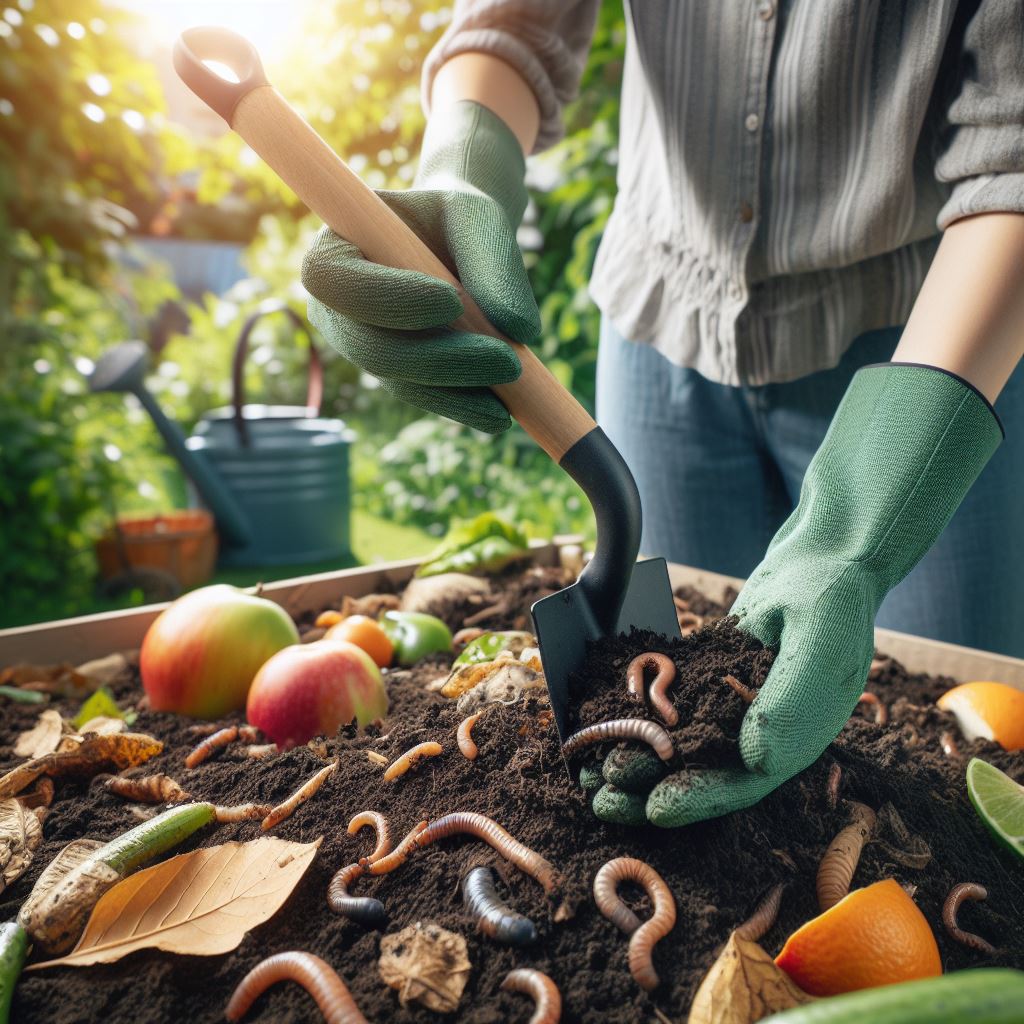Composting: Turning Waste into Farming Gold
Last Updated on November 30, 2023
Introduction to composting
Composting is the process of converting organic waste into nutrient-rich soil, essential for farming.
It plays a vital role in sustainable agriculture, reducing waste, and promoting environmental conservation.
Composting has been practiced for centuries, with evidence dating back to ancient civilizations such as the Romans and Greeks.
Over time, the knowledge and techniques of composting have evolved, leading to more efficient and effective methods.
Definition and Importance of Composting
Composting is the natural decomposition of organic materials, such as food scraps, yard waste, and animal manure.
By composting these materials, we can divert waste from landfills and create valuable fertilizer for plants.
Compost provides essential nutrients to plants, improves soil structure, retains moisture, and reduces the need for chemical fertilizers.
Additionally, composting reduces greenhouse gas emissions, as organic waste in landfills produces harmful methane gas.
Brief History of Composting
Composting has a rich history that dates back thousands of years.
Ancient civilizations recognized the benefits of composting and used it to nourish their crops.
In more recent times, composting gained popularity during the 1960s and 1970s environmental movement.
Nowadays, composting is widely practiced by individuals, communities, and even on a larger scale in commercial agriculture.
Overall, composting is a simple yet powerful solution to address waste management, promote sustainable agriculture, and protect the environment.
The benefits of composting
Increased soil fertility
- Composting enriches the soil with nutrients essential for plant growth.
- The microbial activity stimulated by composting helps break down organic matter into available nutrients.
Improved soil structure
- Composted soil has enhanced water retention capacity, reducing the need for frequent irrigation.
- The composted soil also prevents erosion by binding particles together and forming a stable structure.
Reduction of waste
- Composting reduces the amount of waste sent to landfills, easing the burden on these sites.
- By minimizing the amount of organic waste in landfills, composting reduces greenhouse gas emissions.
Composting is not only a sustainable waste management solution, but it also provides numerous benefits to soil health and the environment.
By understanding the advantages of composting, individuals and communities can make informed choices to promote a greener and healthier future.
Increased soil fertility
Composting plays a significant role in increasing soil fertility. One of the main advantages is nutrient enrichment.
Organic waste materials such as food scraps, yard trimmings, and plant residues contain essential nutrients like nitrogen, phosphorus, and potassium.
When properly composted, these nutrients become readily available for plants, promoting healthy growth and improving crop yield.
In addition to nutrient enrichment, composting also stimulates microbial activity in the soil.
Microorganisms, like bacteria and fungi, play a crucial role in converting organic matter into simpler forms that plants can absorb.
By adding compost to the soil, the microbial population increases, resulting in better breakdown of organic matter and improved nutrient availability.
Improved soil structure
Composting contributes to the overall improvement of soil structure. Compost is a soil amendment with excellent water retention capacity.
When incorporated into the soil, compost acts like a sponge, absorbing and holding water.
This allows for better distribution of moisture throughout the soil profile and reduces the need for excessive irrigation.
As a result, plants have access to a consistent water supply, reducing the risk of drought stress and promoting healthier growth.
Furthermore, composted soil helps prevent erosion. The organic matter in compost helps bind soil particles together, creating stable aggregates.
This prevents soil erosion caused by wind or water. The stable structure allows the soil to withstand heavy rainfall, reducing runoff and protecting against topsoil loss.
Improved soil structure also enhances root penetration and aeration, facilitating healthier plant development.
Reduction of waste
One of the most significant benefits of composting is the reduction of waste sent to landfills. Organic waste, such as food scraps and yard waste, is a substantial contributor to landfill volume.
By composting these materials, they are diverted from the waste stream, reducing the amount of waste that occupies landfill space.
This significantly extends the lifespan of landfills and reduces the associated costs and environmental impacts.
Additionally, composting helps minimize greenhouse gas emissions. When organic waste decomposes in landfills, it produces methane, a potent greenhouse gas with a significant impact on climate change.
By diverting organic waste to composting facilities, methane emissions are minimized, contributing to the reduction of greenhouse gas emissions.
Overall, composting offers a range of benefits, from enhancing soil fertility and structure to reducing waste and greenhouse gas emissions.
The practice of composting is a simple and effective way for individuals and communities to contribute to a healthier environment and sustainable agriculture.
By actively participating in composting initiatives, we can turn waste into valuable farming gold and cultivate a greener planet for generations to come.
Read: Aquaponics: A Sustainable Food Production System
Composting methods
Traditional composting
- Green and brown material ratio: Achieving the right balance promotes decomposition and prevents foul odors.
- Turning and aerating the pile: Regularly mixing the compost helps to provide oxygen and speed up the process.
Vermicomposting
- Introduction to worms: These little creatures play a vital role in breaking down organic waste.
- Worm bin construction and maintenance: Creating a suitable environment for worms and managing the bin properly.
Bokashi composting
- Aerobic fermentation process: Beneficial microorganisms ferment the waste, producing a nutrient-rich liquid.
- Effective use of kitchen scraps: The method allows for the composting of all kinds of food waste, including meat and dairy.
Composting is a remarkable technique that transforms organic waste into valuable compost, providing nourishment to plants and promoting a sustainable environment.
There are various methods to compost effectively, each with its own benefits and requirements.
Traditional composting
Traditional composting is a widely used method that involves creating a compost pile using a mixture of green and brown materials.
The ratio of these materials is crucial to maintain a balanced environment for decomposers.
Green materials, such as grass clippings and fruit scraps, provide nitrogen, while brown materials, such as dried leaves and twigs, provide carbon.
The ideal ratio is around 30 parts carbon to 1 part nitrogen.
In addition to the right materials, turning and aerating the pile is essential. This process helps incorporate oxygen, which accelerates decomposition and prevents unpleasant odors.
Regularly turning the pile ensures even distribution of moisture and heat, resulting in faster breakdown of organic matter.
Vermicomposting
Vermicomposting utilizes the power of worms to decompose organic waste. Worms, such as red wigglers or Eisenia fetida, are excellent decomposers that consume organic matter and produce high-quality compost.
Creating a worm bin is the first step in vermicomposting. The bin should be well-ventilated and have multiple layers to house the worms.
Bedding materials such as shredded newspaper or cardboard serve as their habitat.
Maintaining the worm bin involves providing proper moisture levels and a balanced diet for the worms.
The worms feed on kitchen scraps, such as fruit and vegetable peelings, coffee grounds, and eggshells. Avoid adding oily, salty, or acidic foods to the bin.
Bokashi composting
Bokashi composting is an anaerobic fermentation process that incorporates a mixture of food waste and effective microorganisms (EM).
This method allows for the composting of all kitchen scraps, including meat, fish, and dairy products.
The process begins by layering food waste in a Bokashi bin and sprinkling it with EM. The EM helps to ferment the waste, breaking it down without producing foul odors.
The liquid produced, known as Bokashi juice, is full of beneficial nutrients and can be used as a liquid fertilizer.
Bokashi composting is suitable for those with limited space or an aversion to traditional composting methods.
The resulting Bokashi compost can be buried in soil or added to a traditional compost pile to complete the decomposition process.
Regardless of the chosen composting method, each offers an environmentally friendly solution to reduce waste, enrich soil, and support plant growth.
Adopting composting practices not only benefits individual gardeners but also contributes to the overall health of the planet.
Read: Climate-Smart Agriculture: Adapting to Change
Choosing compostable materials
Organic kitchen waste
- Fruit and vegetable scraps
- Coffee grounds and filters
- Eggshells
Yard waste
- Grass clippings
- Leaves and branches
Other compostable materials
- Shredded paper
- Wood ash
- Manure
When it comes to composting, the materials you choose are crucial. To ensure a healthy and effective composting process, it’s important to select the right ingredients.
Here are some compostable materials that you can use to turn your waste into farming gold:
Organic kitchen waste
Organic kitchen waste is an excellent source for compost. It consists of fruit and vegetable scraps, which are rich in nutrients.
These scraps can be chopped into smaller pieces to speed up the decomposition process. Additionally, coffee grounds and filters can be added to the compost pile.
The coffee grounds provide nitrogen, whereas the filters help with moisture retention. Don’t forget to include eggshells as well. They add calcium to the compost, which is beneficial for plant growth.
Yard waste
Yard waste is another great addition to your compost pile. Grass clippings can be easily obtained from mowing your lawn.
They contain nitrogen and add moisture to the compost. Leaves and branches are also valuable compostable materials.
They provide carbon and add bulk to the pile. Be sure to shred larger leaves and branches to speed up decomposition.
Other compostable materials
In addition to kitchen and yard waste, there are other materials you can add to your compost pile. Shredded paper is an excellent source of carbon.
You can use newspapers, cardboard, or even office paper. These materials help maintain proper moisture levels and prevent the compost from becoming too wet.
Wood ash is another useful ingredient. It provides potassium and small amounts of other nutrients.
However, be cautious with the amount of ash you add, as excessive amounts can raise the pH levels of the compost.
Lastly, consider adding manure to your pile. Animal manure, such as cow or horse manure, provides nitrogen and helps break down the materials faster.
When choosing compostable materials, it’s important to maintain a balance between green (nitrogen-rich) and brown (carbon-rich) materials.
Green materials provide essential nutrients, while brown materials help with aeration and moisture retention. Aim for a ratio of approximately 3 parts brown materials to 1 part green materials.
Remember, not all materials can be composted. Avoid adding oily or fatty food scraps, meat, bones, and dairy products as they can attract pests and slow down the decomposition process.
Additionally, avoid using plants treated with pesticides or herbicides, as these chemicals can hinder the growth of beneficial organisms in the compost.
By carefully selecting the right compostable materials, you can create a nutrient-rich and healthy compost.
This will not only help reduce waste but also provide your plants with the nourishment they need to thrive. So start composting today and turn your waste into farming gold!
Read: Renewable Energy in Farms: Sun, Wind, Biomass

Compost Maintenance and Troubleshooting
Proper watering and moisture control
- Maintain a consistent level of moisture in the compost pile by watering it regularly.
- Use a moisture meter to check the moisture content and adjust accordingly.
- Avoid over-watering, as it can lead to a slimy and anaerobic environment.
Balancing carbon and nitrogen ratios
- Monitor the carbon and nitrogen content in the compost pile to maintain an optimal ratio.
- Add carbon-rich materials such as dried leaves, straw, or shredded paper to balance high nitrogen content.
- Avoid an excess of nitrogen-rich materials like fresh grass clippings, which can cause a smelly and slow-to-decompose pile.
Recognizing signs of a healthy or problematic compost pile
Temperature changes
- Monitor the internal temperature of the compost pile using a compost thermometer.
- A healthy compost pile should reach temperatures between 130°F and 160°F, indicating active decomposition.
- If the temperature drops significantly or remains consistently low, it may indicate a lack of microbial activity.
Odor indications
- A properly maintained compost pile should have an earthy smell, similar to that of a forest floor.
- Foul odors, such as a rotten or ammonia-like smell, can indicate an imbalance in the compost or lack of oxygen.
Pest infestations
- Regularly inspect the compost pile for pests like rats, mice, or flies.
- An excessive presence of pests may indicate that the compost pile is not properly maintained or has food waste attracting them.
- Take necessary steps to secure the compost pile and eliminate any potential pest habitats.
Maintaining a healthy compost pile requires attention to proper watering, balancing carbon and nitrogen ratios, and recognizing signs of potential issues.
By following these guidelines, you’ll ensure a thriving composting process and reap the benefits of nutrient-rich compost for your gardening or farming endeavors.
Read: Polyculture Farming: Diverse Crops, Better Yield
Harvesting and utilizing compost
In the previous section, we explored the process of composting, from selecting the right materials to maintaining optimal conditions for decomposition.
Now, we will delve into the exciting rewards of all that hard work – harvesting and utilizing compost.
Determining compost readiness
Before reaping the benefits of your compost pile, it’s crucial to ensure that it has reached a suitable level of maturity.
Several signs indicate compost readiness: a dark brown or black color, an earthy smell, and a crumbly texture. Avoid using compost that still appears unfinished or gives off an unpleasant odor.
Methods for extracting finished compost
Once your compost is ready, you have several options for extracting it.
One common method is to sift the compost through a screen or mesh, separating the finer, fully decomposed material from larger chunks or scraps that need more time to break down.
Alternatively, you can use a compost tumbler or aerated windrow system to facilitate the process.
Application of compost in farming and gardening
Now that you have high-quality finished compost, it’s time to put it to good use in your farming or gardening endeavors.
Topsoil amendment
One of the primary benefits of compost is its ability to improve soil structure.
By incorporating compost into your topsoil, you can enhance its ability to retain water, prevent erosion, and promote root development.
Spread a layer of compost over your planting area and gently mix it into the existing soil.
Mulching and erosion prevention
Compost makes an excellent mulch, providing a protective layer that conserves moisture, suppresses weeds, regulates soil temperature, and prevents erosion.
Apply a thick layer of compost around the base of your plants, leaving a gap around the stem to avoid rotting.
Plant nutrient supplementation
Compost is a fantastic source of essential nutrients for plants. Rich in organic matter, it nourishes your crops with a range of vital elements like nitrogen, phosphorus, and potassium.
Use compost as a natural fertilizer by either incorporating it into the soil before planting or applying it as a side dressing during the growing season.
As you can see, the applications of compost in farming and gardening are numerous and highly beneficial.
Not only does it improve soil health, but it also promotes sustainable practices, reducing the need for chemical fertilizers and pesticides.
By harnessing the power of compost, you contribute to the cycle of life, transforming waste into valuable resources.
So, the next time you’re tossing food scraps or garden waste into your compost pile, remember the incredible potential it holds to nurture and nourish your plants. Happy composting!
Conclusion
Recap of Composting Benefits
Composting transforms waste into nutrient-rich gold for soil, fostering healthier plants and ecosystems. It curtails landfill burden, mitigates greenhouse gas emissions, and nourishes the earth sustainably.
Encouragement for Readers to Start Composting
Embrace the power of composting! Initiate this simple, impactful practice at home to reduce waste, enrich your garden, and contribute to a greener planet.
Importance of Sustainable Farming Practices
Composting is a cornerstone of sustainable farming. By recycling organic waste, it promotes soil health, minimizes reliance on synthetic fertilizers, and champions an eco-friendly approach to agriculture.
Embark on your composting journey today—small actions ripple into significant ecological benefits, paving the way for a more sustainable and harmonious farming future.


